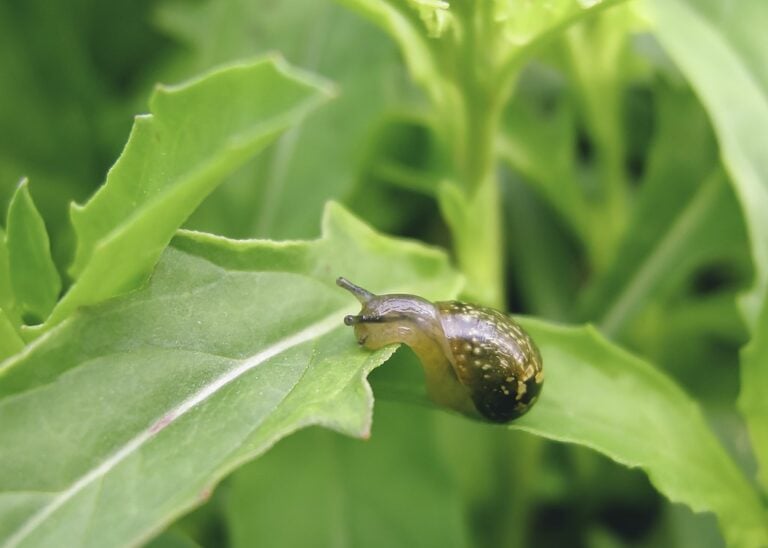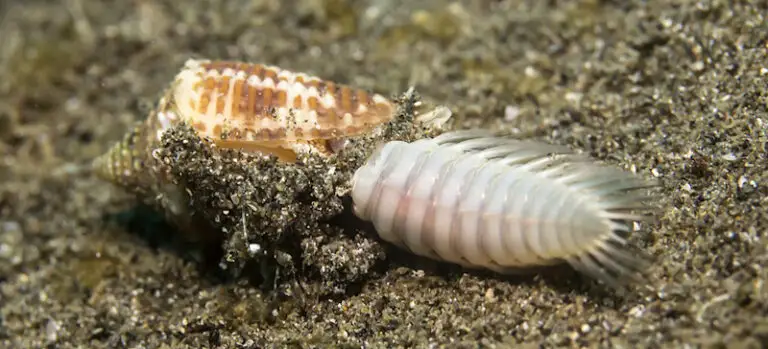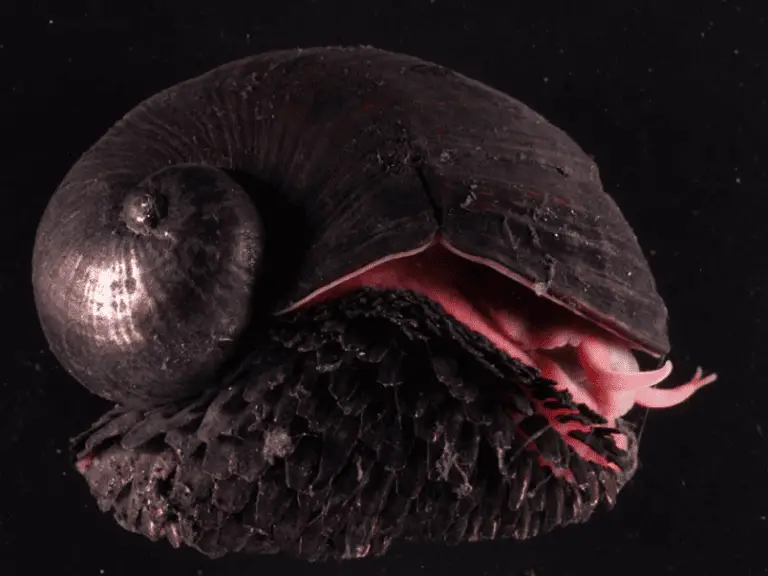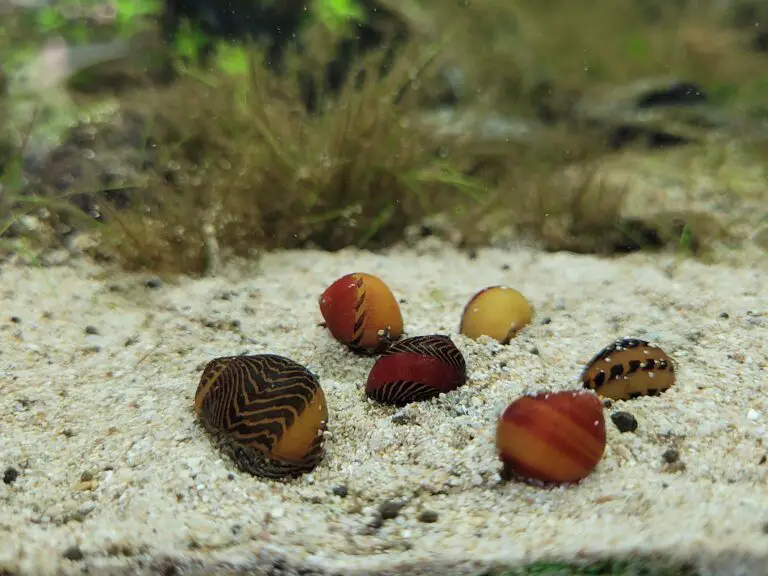The secret World of Mystery Snails Unveiled
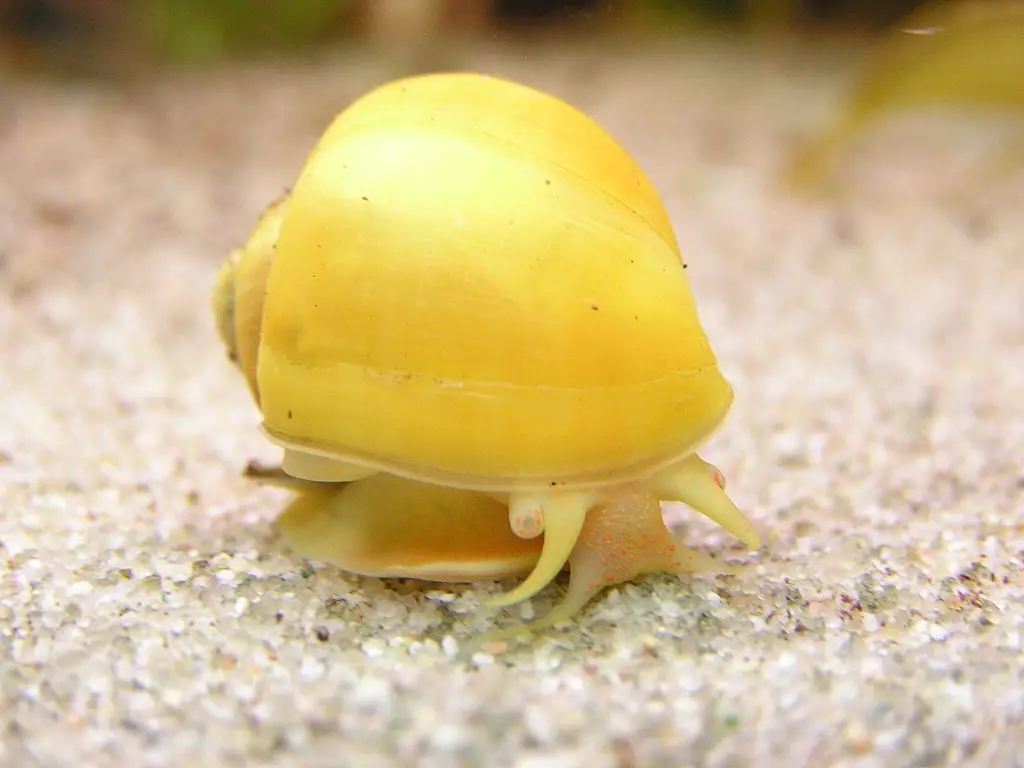
Mystery snails, also known as pomacea bridgesii, are freshwater snails native to South America. They are a popular aquarium pet because of their unique appearance and ease of care. These snails get their name from their tendency to disappear for hours at a time, only to reappear in a different location, making them quite mysterious creatures.
These gastropods have an operculum, which is like a trapdoor that they use to close off the opening of their shells when they feel threatened or want to protect themselves from predators. The shell itself is typically between 2-3 inches in diameter, with various color variations including brown, yellow and even blue.
One interesting fact about mystery snails is that they are sometimes considered pests in certain areas due to their ability to reproduce quickly and overpopulate bodies of water. However, in a controlled environment like an aquarium, mystery snails can be fascinating creatures to observe.
Why They Are Called “Mystery” Snails
As mentioned earlier, mystery snails have earned this moniker due to their elusive nature. They can often be found hiding out in small spaces within aquariums (such as under rocks or behind plants), disappearing for hours on end before reappearing out of nowhere.
One theory behind this behavior is that mystery snails are nocturnal creatures who prefer to come out only at night when it’s dark and quiet. Another possibility is that they simply enjoy exploring their surroundings and searching for new places to hide.
Regardless of the reason behind it, the mystery surrounding these fascinating creatures only adds to their appeal as pets. Whether you’re a seasoned aquarium hobbyist or just beginning your journey into fish-keeping, adding a couple of mystery snails into your tank can be an excellent choice.
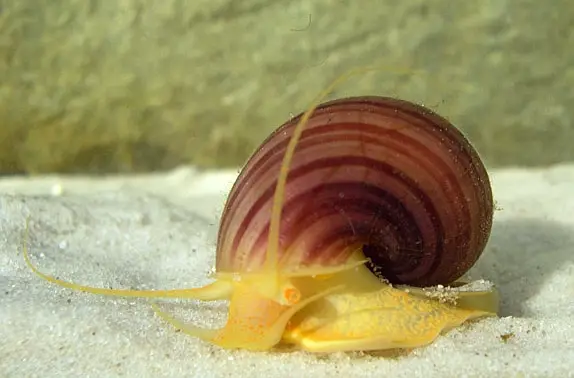
Appearance
Mystery snails are known for their unique appearance that sets them apart from other aquatic creatures. They have a distinct body shape and shell design that makes them easy to spot in an aquarium or in the wild.
Physical Characteristics of a Mystery Snail
Mystery snails have a cone-shaped body that is covered with a hard, calcified shell. Their bodies range in size from about one to two inches in length, depending on their age and health. They have two pairs of tentacles on their head, with the upper pair being longer than the lower pair.
One of the most interesting things about mystery snails is that they are able to retract fully into their shells if they feel threatened or scared. When they do this, their operculum, which is a small plate located at the opening of their shells, closes tightly to protect them from harm.
Different Color Variations
Mystery snails come in many different color variations, making them popular among aquarium enthusiasts who like to add some variety to their tanks. The most common color variation is brown or beige, but they can also be found in shades of blue, green, gold and black.
Some mystery snails even have interesting patterns on their shells that resemble swirls or stripes! The color and pattern variations can depend on where the snail was bred and what kind of diet it has been fed.
Shell Size and Shape
The shells of mystery snails are usually large and round with very little tapering towards the top. Some species may have slightly elongated shells though.
The size can vary greatly between individuals depending on age and environment but generally ranges between 1-2 inches in length. The texture of the shell is smooth when young but may develop ridges as it ages over time.
The thickness of the shell also varies depending on the environment and diet of the snail. Mystery snails are known for their hard, durable shells that can withstand a lot of wear and tear.
Overall, mystery snails have a distinct appearance that makes them an interesting addition to any aquarium. From their unique body shape to their colorful shells, they are sure to catch the eye of any curious onlooker.
Habitat and Distribution
Where Mystery Snails Can Be Found in the Wild
Mystery snails, scientifically known as Pomacea bridgesii, are native to South America, specifically Brazil and Argentina. In the wild, they typically inhabit slow-moving waterways such as rivers, streams, and ponds. They can also be found in wetlands and areas with a lot of vegetation.
One interesting characteristic of mystery snails is their ability to breathe both underwater and above the surface. They have a long siphon that allows them to take in air from above the water while still submerged.
This adaptation allows them to survive in areas with low oxygen levels. It’s worth noting that while mystery snails are considered an invasive species in some parts of the world due to their ability to reproduce quickly and outcompete native species, they have a valuable role in their natural ecosystem by helping to clean up decaying organic matter.
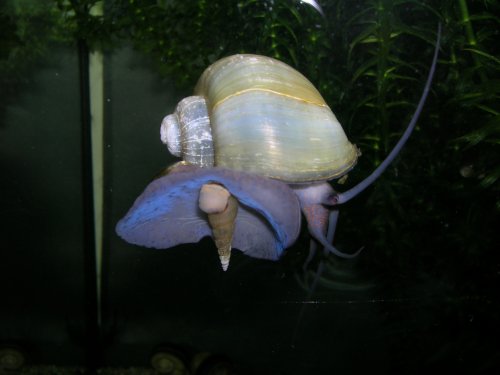
Ideal Aquarium Conditions for Keeping Them as Pets
If you’re interested in keeping mystery snails as pets, it’s important to ensure that their aquarium mimics their natural habitat as closely as possible. A tank size of at least 10 gallons is recommended for one or two adult mystery snails.
Water quality is also crucial for these creatures – make sure your tank has good filtration and keep on top of regular water changes. The ideal temperature range for mystery snails is 68-82°F (20-28°C), so consider incorporating a heater into your setup if necessary.
Mystery snails will appreciate plenty of hiding spots such as rocks or plants within their tank, particularly during molting periods when they may feel more vulnerable. They also like having access to surfaces above the waterline where they can lay eggs – pieces of driftwood or even PVC pipes can work well for this purpose.
When it comes to feeding, mystery snails are pretty easy to please. They’ll eat a variety of foods including algae, vegetables like zucchini or spinach, and commercial sinking pellets.
Just be sure not to overfeed them – these snails can produce a lot of waste which can negatively impact water quality. Overall, with the right care and attention, mystery snails can make fascinating and enjoyable pets for those interested in aquatic life.
Diet and Feeding Habits
What Mystery Snails Eat
Mystery snails are omnivores, meaning they eat both plant and animal matter. They will eat algae, decaying plant matter, and even dead fish in your aquarium. However, their primary diet consists of live or boiled vegetables like spinach, cucumber, lettuce, zucchini, kale, etc. You can also give them fish food pellets; however, make sure to monitor how much you feed them as overfeeding can lead to health problems.
One thing to keep in mind is that mystery snails require a high calcium diet for their shells to grow properly. You can supplement their diet with calcium-rich foods such as cuttlebone or crushed eggshells.
Frequency and Amount of Feeding
The amount of food you should feed your mystery snail depends on its size. As a general rule of thumb, a fully grown mystery snail should be fed one veggie slice a day or 4-5 small pellets per week.
Younger or smaller snails may require less food than an adult one. It’s essential not to overfeed your mystery snail as they are prone to obesity like other animals; too much food will cause them health problems such as lethargy and shell deformities.
When feeding your mystery snail vegetables like zucchini or cucumber slices – remove the leftovers after 24 hours from the tank so it does not start rotting and polluting the water; this also helps prevent the growth of bacteria which can lead to sickness in Mystery Snails. Additionally Keep in mind if you have any other fish species sharing the same tank with your Mystery Snail – those fish may eat some portions that are intended for your snail so observing how much each eats tends to be important.
: When feeding your Mystery Snail it is essential to balance their diet, feed them the right amount and remove the leftovers. By obeying those rules, you will have a healthy and happy snail.
Reproduction of Mystery Snails
Mystery snails are hermaphroditic, which means they have both male and female reproductive organs. However, they need a partner to mate and reproduce. During mating, one snail will act as the male, and the other will act as the female.
To start the mating process, mystery snails begin by courting each other. They will touch tentacles and crawl around each other for several hours before eventually mating.
After mating, the female mystery snail will lay small, white or pink eggs that look like beads in clusters on plants or hard surfaces in the aquarium. The eggs are often attached to each other in a gelatinous mass that can be separated into smaller groups if necessary.
Gestation Period
The gestation period for mystery snails is approximately two to four weeks. During this time, it is important to maintain stable water conditions in the aquarium to ensure healthy development of the eggs.
It is worth noting that some species of mystery snails are known to occasionally store sperm from previous mates and use it later in fertilization. This can lead to different colored offspring within a single clutch of eggs.
Hatching Process
Once hatched, baby mystery snails will emerge from their egg sacs as small versions of their parents but without any shell pigmentation yet. In fact, baby mystery snails do not develop coloration until they are several weeks old. To ensure successful hatching of mystery snail eggs, you’ll want to make sure there’s plenty of oxygenated water flowing over them during incubation – this helps with survival rates by keeping them well-fed throughout their early development stages!
Breeding mystery snails can be an exciting experience for fishkeepers looking to expand their knowledge about aquatic life forms beyond fish alone! With proper care and attention given throughout the gestation and hatching process, you can enjoy watching these little creatures grow up into colorful adult snails.
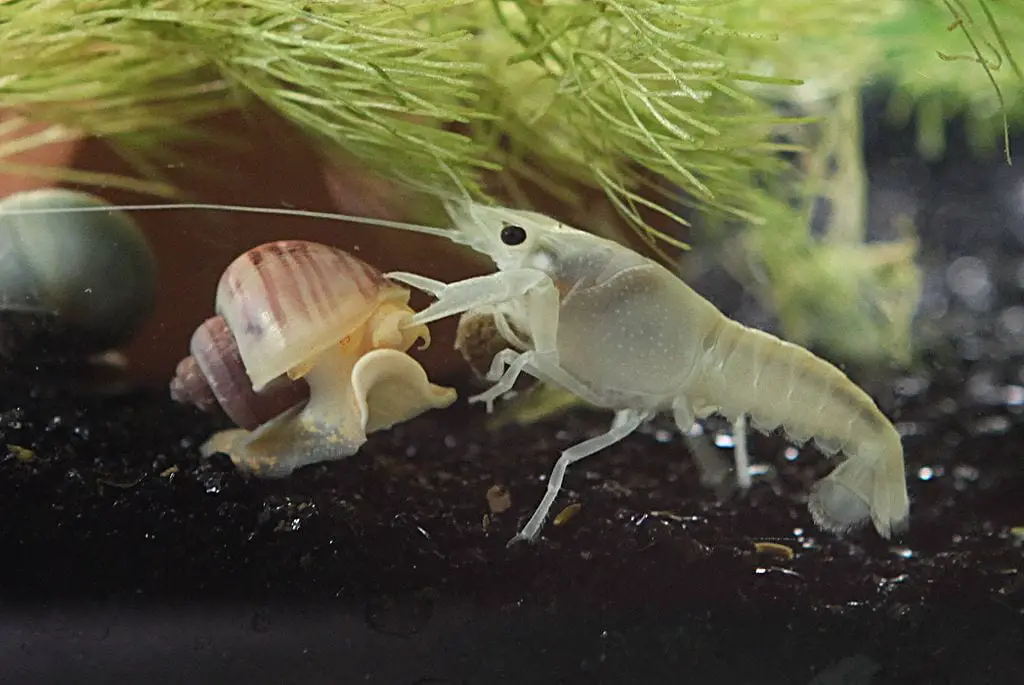
Behavior and Personality
Mystery snails are fascinating creatures that can add a lot of personality to your aquarium. They are not just inanimate objects, but living creatures with unique personalities.
Each mystery snail has its own personality that sets it apart from other snails. Some can be playful, curious, shy or even aggressive.
Do they have personalities?
Yes, mystery snails do have personalities. They are not just a decoration for your aquarium, but pets that can bring life and intrigue to your tank.
Some might think that all snails are the same, but this is far from true when it comes to mystery snails. Some mystery snails may prefer to hide in their shells while others might be more outgoing and adventurous.
Some may even follow you around the tank like a puppy dog! It is fascinating to watch how each individual mystery snail interacts with its environment.
How they interact with other fish in the tank
Mystery snails generally get along well with other fish species in the tank. They are peaceful creatures and will not pick fights or cause aggression towards other fish.
In fact, some fish species such as bettas or gouramis will form an unlikely friendship with their smaller counterparts – the mystery snail! Betta fish have been known to rest on top of the shell of a roving mystery snail while gouramis seem to enjoy playing “tag” with these nimble little creatures.
It is important to note that some larger predatory species such as puffers or cichlids may view these unsuspecting escargots as tasty little snacks. So if you plan on keeping these types of fish together then you’ll need to monitor their behavior closely.
Their activity levels
Mystery Snails are active during both day and night time hours but they tend to be more active at night. They are known to wander around the tank leaving a slime trail behind them as they move.
During the day, some may hide under rocks or plants in search of a cool and shady place to rest. While others may be out and about looking for food or exploring their surroundings.
How they sleep
It is interesting to note that mystery snails do sleep, but not in the way that we would expect. Their shells provide them with a safe haven where they can retreat when it’s time for a nap.
When sleeping, mystery snails retract their whole body into their shell and close their operculum (trapdoor) tightly shut. This keeps them safe from predators whilst providing them with an ideal environment for sleeping peacefully.
Personality traits
Some mystery snails have been observed displaying unique personality traits such as being more adventurous than others, shy or even playful. In general, most mystery snails are peaceful creatures that won’t cause any trouble in your aquarium. However, it’s important to note that each individual may have its own unique personality that will set it apart from other snails.
Mystery snails have been known to interact with their owners as well! If you put your hand in the tank and wiggle your fingers around, some mystery snails will actually reach out of their shell to touch you or “feel” what is going on outside of their watery domain!
Health Concerns
Mystery snails are generally hardy creatures that require very little maintenance. However, they are not immune to certain diseases and health issues that can arise if their habitat or diet is not properly maintained. In this section, we will discuss some common health concerns that affect mystery snails and how to prevent and treat them.
Common Health Issues with Mystery Snails
One of the most common health issues that affect mystery snails is a lack of calcium in their diet. This can cause their shells to become weak, thin, or even deform. If you notice any abnormalities in your snail’s shell, it may be a sign that they are not getting enough calcium in their diet.
To prevent this issue, make sure you provide your mystery snail with plenty of food sources high in calcium such as cuttlebone or calcium supplements. Another issue your mystery snail may face is overgrowth of algae on its shell.
While some algae growth on the shell is normal and healthy for the snail, too much can create an unhealthy environment for it. To prevent this issue, you should regularly clean your aquarium water and use an algae scraper to remove excess growth on the shell.
Like all aquatic creatures, mystery snails are susceptible to various bacterial infections and illnesses such as fungal infections and parasites. You should monitor your pet’s behavior closely for signs of lethargy or abnormal behavior which may indicate a potential health problem.
How To Prevent And Treat These Issues
Preventing these issues begins with maintaining a clean habitat for your mystery snail by regularly cleaning the tank water, removing uneaten food promptly from the tank after feeding times end and using appropriate filtration systems designed for aquariums. Additionally, ensure that there is plenty of food available at all times so it does not go hungry.
To prevent calcium deficiency from impacting your snail, include calcium-rich food sources such as cuttlebone, kale leaves or shrimp. Preparing their diet to be at least 50% vegetative is essential for preventing shell erosion.
In the case of an algae overgrowth, you can remove excess algae from the snail’s shell with a soft brush. Putting too much pressure when brushing can damage the delicate epidermis of the snail.
When you notice any signs of infection or illness in your mystery snail, it’s essential to act fast and take them to a veterinarian who specializes in aquatic animals. They will provide appropriate antibiotics or medication that is needed for treatment.
Taking care of your mystery snail by providing a healthy habitat and nutrition while regularly monitoring their behavior can prevent most health issues that they may face. If treated immediately by a veterinarian any issues that do arise are rarely life-threatening and can be treated with ease.
Fun Facts About Mystery Snails
They Have Unique Breathing Mechanisms
Did you know that mystery snails are amphibious? They have the ability to breathe both underwater and above water.
They use a special breathing tube called a “pneumostome” to extract oxygen from the air. If you see your mystery snail sticking its “nose” out of the water, it’s not just being cute – it’s actually getting air!
They Can Live Up to Three Years
Mystery snails have a relatively long lifespan for an aquarium pet, typically living up to three years with proper care. During their lifespan, they can grow up to two inches in shell diameter and become quite plump. Make sure you have enough space in your tank for them to grow!
Their Shells Can Change Color
While many people think of mystery snails as brown or golden, they actually come in a variety of colors including black, blue, pink, and even ivory. What’s even more interesting is that their shells can change color depending on their diet and environment! A mystery snail with a blue shell might turn green over time if it’s eating lots of algae.
They Are Mollusks With Teeth
All mollusks have a radula – a complex ribbon of teeth used for scraping food – but did you know that mystery snails actually have two radulas? These tiny teeth help them munch on algae and other vegetation in your tank.
Frequently Asked Questions
Q1: What is a mystery snail?
A1: A mystery snail is a species of freshwater snail, specifically Pomacea bridgesii. They are a popular choice for freshwater aquariums due to their peaceful nature and the beneficial role they play in managing tank cleanliness by eating algae and detritus.
Q2: Where do mystery snails come from?
A2: Mystery snails are native to South America, particularly countries like Brazil, Bolivia, and Paraguay. They have, however, been introduced to other parts of the world.
Q3: What do mystery snails eat?
A3: Mystery snails are generally herbivorous. They enjoy a diet of plant matter and algae, including algae growths on tank surfaces and detritus. They can also be fed blanched vegetables such as lettuce, zucchini, and spinach, as well as specialized sinking pellets.
Q4: What is the lifespan of a mystery snail?
A4: The average lifespan of a mystery snail is around one to two years in a well-maintained aquarium setting. However, their lifespan can vary depending on factors such as diet, tank conditions, and overall health.
Q5: How can you tell the gender of a mystery snail?
A5: Unlike some other snails, it’s challenging to distinguish male from female mystery snails. They do not have obvious external differences. The only reliable way to tell their gender is during mating, as the male is usually on top.
Q6: How do mystery snails reproduce?
A6: Mystery snails are gonochoristic, which means there are separate males and females, and both are needed for reproduction. After mating, the female will lay eggs above the waterline in the aquarium where they will remain for a few weeks until the baby snails hatch.
Q7: Are mystery snails good for your aquarium?
A7: Yes, mystery snails are a beneficial addition to most freshwater aquariums. They help maintain cleanliness by eating excess algae and dead plant material, which reduces the need for manual cleaning. However, it’s essential to note that they can eat live plants as well if they are not adequately fed.
Q8: How big do mystery snails get?
A8: On average, adult mystery snails can reach about 2 inches in diameter. However, their size can vary depending on their diet and overall health.
Q9: How to care for a mystery snail?
A9: Mystery snails thrive in a freshwater aquarium with a stable environment. They prefer slightly alkaline pH and a temperature range of 68 to 82 degrees Fahrenheit. A diet rich in plant matter and adequate hiding places are also beneficial. They also need access to the water’s surface to breathe, as they have both gills and a lung.
Q10: Do mystery snails carry diseases?
A10: Like any other pet, mystery snails can potentially carry parasites or bacterial infections that may affect their health. However, they are not known for carrying diseases that are transmissible to humans or other fish species in the aquarium. It’s always a good practice to quarantine new arrivals before introducing them to an established tank to prevent possible contamination.
Conclusion
Mystery snails are fascinating creatures with unique adaptations and behaviors that make them stand out from other aquarium pets. Whether you’re drawn to their colorful shells or curious about their breathing abilities, there’s no denying that these little guys add personality and charm to any tank setup.
With proper care – including a healthy diet, clean water, and enough space to grow – your mystery snail can live a long and happy life. So go ahead and add one (or more!) to your aquarium setup, and enjoy the wonder of these aquatic wonders.

